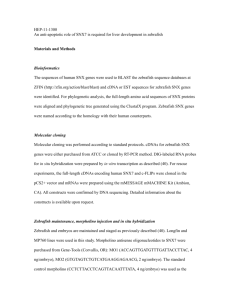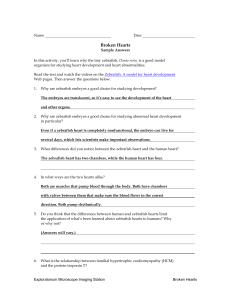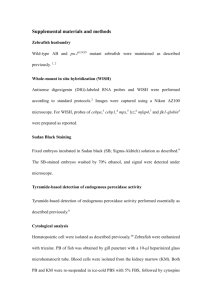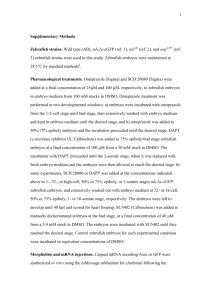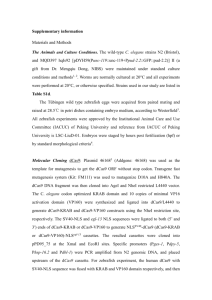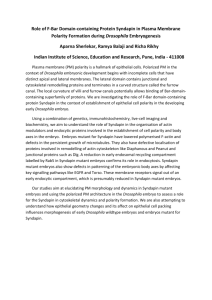Supplementary Notes - Word file
advertisement
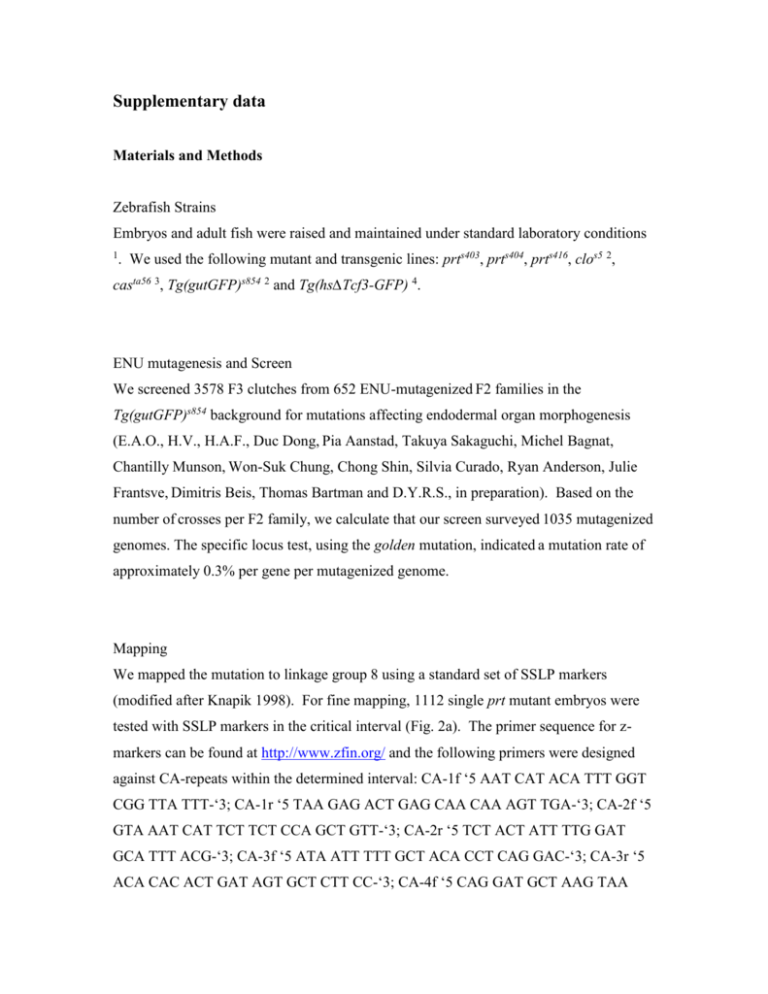
Supplementary data Materials and Methods Zebrafish Strains Embryos and adult fish were raised and maintained under standard laboratory conditions 1 . We used the following mutant and transgenic lines: prts403, prts404, prts416, clos5 2, casta56 3, Tg(gutGFP)s854 2 and Tg(hs∆Tcf3-GFP) 4. ENU mutagenesis and Screen We screened 3578 F3 clutches from 652 ENU-mutagenized F2 families in the Tg(gutGFP)s854 background for mutations affecting endodermal organ morphogenesis (E.A.O., H.V., H.A.F., Duc Dong, Pia Aanstad, Takuya Sakaguchi, Michel Bagnat, Chantilly Munson, Won-Suk Chung, Chong Shin, Silvia Curado, Ryan Anderson, Julie Frantsve, Dimitris Beis, Thomas Bartman and D.Y.R.S., in preparation). Based on the number of crosses per F2 family, we calculate that our screen surveyed 1035 mutagenized genomes. The specific locus test, using the golden mutation, indicated a mutation rate of approximately 0.3% per gene per mutagenized genome. Mapping We mapped the mutation to linkage group 8 using a standard set of SSLP markers (modified after Knapik 1998). For fine mapping, 1112 single prt mutant embryos were tested with SSLP markers in the critical interval (Fig. 2a). The primer sequence for zmarkers can be found at http://www.zfin.org/ and the following primers were designed against CA-repeats within the determined interval: CA-1f ‘5 AAT CAT ACA TTT GGT CGG TTA TTT-‘3; CA-1r ‘5 TAA GAG ACT GAG CAA CAA AGT TGA-‘3; CA-2f ‘5 GTA AAT CAT TCT TCT CCA GCT GTT-‘3; CA-2r ‘5 TCT ACT ATT TTG GAT GCA TTT ACG-‘3; CA-3f ‘5 ATA ATT TTT GCT ACA CCT CAG GAC-‘3; CA-3r ‘5 ACA CAC ACT GAT AGT GCT CTT CC-‘3; CA-4f ‘5 CAG GAT GCT AAG TAA GTG TGT GAG-‘3; CA-4r ‘5 GGC TTC CTG AAC ATC TAA TGT AAC-‘3. For cloning and sequencing of the wnt2bb gene, total RNA was extracted from wildtype and prt mutant embryos using Trizol (Invitrogen). cDNAs were generated by performing RT-PCR using the Superscript Kit (Invitrogen). An initial fragment of about 850 bp was amplified and extended via 3’RACE. PCR products from at least two independent PCR reactions per mutant allele were sequenced and analysed. The prt/wnt2bb nucleotide sequence was deposited at Genbank with the accession number DQ231559. Mosaic experiments Donor embryos were injected with 2.5% rhodamine-dextran, and cells transplanted into hosts at the 1000 cell stage. To target wild-type cells to the mesoderm, cells were transplanted to the margin. Two independent groups of cells were transplanted into each host embryo, 90 degrees apart from each other, to increase the likelihood of contributing to the LPM. Homozygous prt mutant host embryos were obtained from homozygous prt mutant fish. Histochemical methods Whole-mount in situ hybridisation was performed as previously described 5, using the following probes: hhex 6, cp 7, sePb 8,9, gsc 10 and foxA1 11. A prt in situ probe (850 bp at the 3’end of the gene) was cloned into the pCS2+ vector. The antisense probe was generated by linearizing the plasmid with BamHI, followed by transcription with T3 polymerase. We used the following antibodies: polyclonal antibody against Prox1 (rabbit, 1:1000; Chemicon), monoclonal antibody against Islet1/2 (1:15; Developmental Studies Hybridoma Bank, clone 39.4D5) and fluorescently conjugated antibodies from Molecular Probes and Jackson Laboratories. Embryos were fixed with 2% PFA overnight at 4C. Manual removal of the yolk was followed by 60 min incubation with 66 mM Tris pH 7.5, 5 mM MgClB, 1 mM 2-Mercaptoethanol and 50 U/ml DNAseI (Roche) at 37˚C, followed by whole-mount antibody staining in PBST (1% Triton in PBS pH 7.3) with 5% Sheep Serum and 1% DMSO added. Stained embryos were embedded in NuSieve GTG low melting agarose and cut into 200 µm sections with a Leica VT1000S vibratome. Images were acquired using a Zeiss LSM5 Pascal confocal microscope and a Zeiss/Bio-Rad Radiance 2100 confocal microscope. The images acquired on the latter microscope were processed using Volocity software (Improvision). Injection - Morpholino antisense oligonucleotides and mRNA overexpression Morpholinos were purchased from GeneTools LLC. We designed a morpholino oligonucleotide targeted against an ATG upstream of the translational start site with the following sequence: ‘5 GTGTGCCATATAAAAGTATTCCCCG-3’. Tg(gutGFP)s854 embryos were injected at the one cell stage with ~2ng of morpholino and assayed between 48 - 54 hpf. For generation of prt mRNA, a full-length fragment was cloned into pCS2+; the mRNA was transcribed using the SP6 mMessage mMachine Kit (Ambion) upon linearization with SacII. One cell stage embryos were injected with 50 – 150 pg of prt mRNA. References: 1. Westerfield, M. The Zebrafish Book. A Guide for the Laboratory Use of Zebrafish (Danio rerio) (University of Oregon Press, Eugene, OR, 2000). 2. Field, H. A., Ober, E. A., Roeser, T. & Stainier, D. Y. Formation of the digestive system in zebrafish. I. Liver morphogenesis. Dev Biol 253, 279-90 (2003). 3. Alexander, J., Rothenberg, M., Henry, G. L. & Stainier, D. Y. casanova plays an early and essential role in endoderm formation in zebrafish. Dev Biol 215, 343-57 (1999). 4. Lewis, J. L. et al. Reiterated Wnt signaling during zebrafish neural crest development. Development 131, 1299-308 (2004). 5. Alexander, J., Stainier, D. Y. & Yelon, D. Screening mosaic F1 females for mutations affecting zebrafish heart induction and patterning. Dev Genet 22, 288-99 (1998). 6. Ho, C. Y., Houart, C., Wilson, S. W. & Stainier, D. Y. A role for the extraembryonic yolk syncytial layer in patterning the zebrafish embryo suggested by properties of the hex gene. Curr Biol 9, 1131-4 (1999). 7. Korzh, S., Emelyanov, A. & Korzh, V. Developmental analysis of ceruloplasmin gene and liver formation in zebrafish. Mech Dev 103, 137-9 (2001). 8. Kryukov, G. V. & Gladyshev, V. N. Selenium metabolism in zebrafish: multiplicity of selenoprotein genes and expression of a protein containing 17 selenocysteine residues. Genes Cells 5, 1049-60 (2000). 9. Kudoh, T. et al. A gene expression screen in zebrafish embryogenesis. Genome Res 11, 1979-87 (2001). 10. Schulte-Merker, S. et al. Expression of zebrafish goosecoid and no tail gene products in wild-type and mutant no tail embryos. Development 120, 843-52 (1994). 11. Odenthal, J. & Nusslein-Volhard, C. fork head domain genes in zebrafish. Dev Genes Evol 208, 245-58 (1998). Figure legends Figure 1 Schematic of the phylogenetic relationship between zebrafish (Dr), mouse (Mm), rat (Rn) and human (Hs) Wnt2 and Wnt2b genes. For the zebrafish proteins, Wnt2bb shows 70% identity and 85% similarity with Wnt2, and 84% identity and 92% similarity with Wnt2ba. Wnt2ba shows 70% identity and 84% similarity with Wnt2. Figure 2 Linking liver formation and Wnt2bb to canonical Wnt signaling. a–i, Interference with canonical Wnt signaling using the Tg(hs∆Tcf3-GFP) line and applying one hour heat-shock at indicated time points led to defects in hepatic development. Offspring of heterozygous carriers were used for these experiments, thus the observed phenotype varies in strength between embryos. a-c, Application of a heat-shock at 16 hpf (14 somites) led to a complete absence (asterisk; c) or strong reduction (arrowheads; b) of the hepatic domain as visualized by hhex expression at 25 hpf. Application of a heat-shock at 21.5 hpf (25 somites) still led to a complete absence (asterisk; f) or strong reduction (arrowhead; e) of the liver bud, whereas treating at 25 hpf only resulted in a reduction of the liver bud (arrowheads; h, i) as assayed by foxA1 expression at 48 hpf. [The actual stage when the embryos were assayed for marker expression is slightly more advanced than indicated due to a more rapid development caused by the heat-shock.] a-i Dorsal views; anterior to the top. j-k, Overexpression of prt mRNA in the early embryo led to an increase of dorsal fates during gastrulation stages as shown by gsc expression. Two different experimental embryos are presented (k, m), one dorsal (k) and one animal pole view (m), respectively; each accompanied by a control embryo (j, l). Arrowheads delineate the gsc expression domain, which is expanded between two- and threefold in experimental embryos (k, m).

